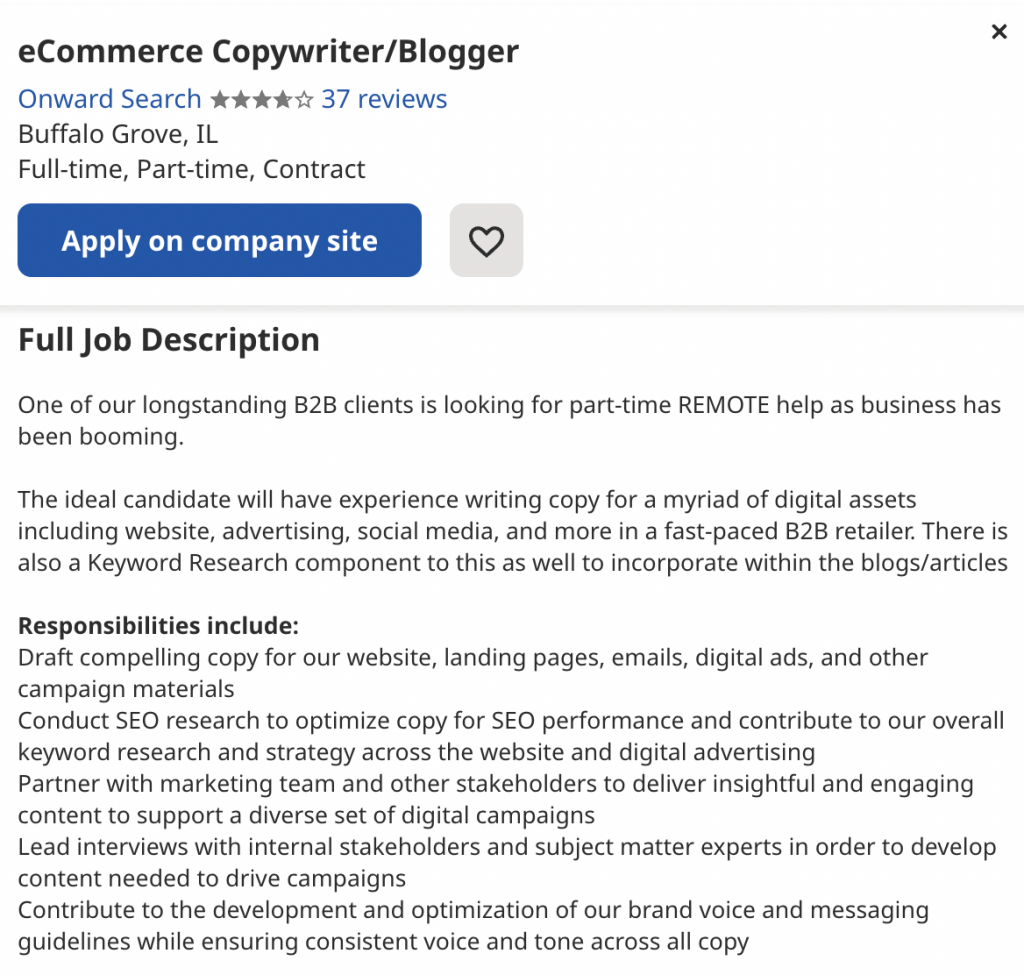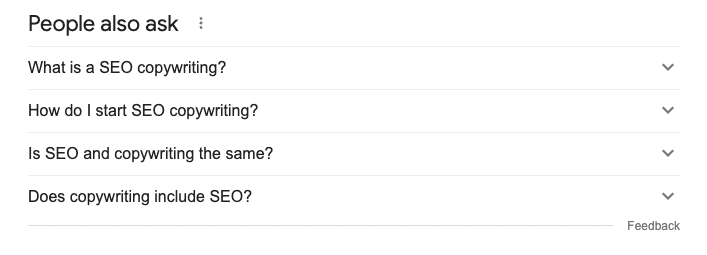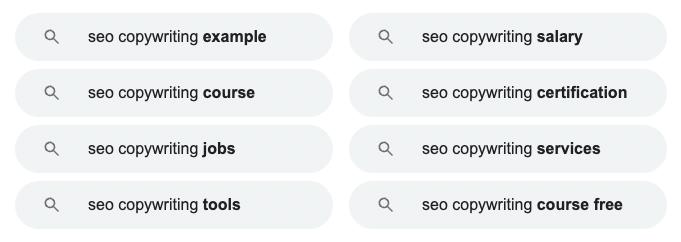If you’re running a website, you need SEO. It’s a must-have.
In fact, 61% of B2B marketers say that SEO and organic traffic generate more leads than any other marketing strategy.
How crazy is that?
This is why SEO copywriting is so important.
Everything you write is technically sales copy, and can be optimized for search engines to drive additional results.
In this blog post, I’ll teach you everything you need to know about SEO copywriting.
I’ll explain what it is, why it’s important, and how to write copy that ranks high on Google. Plus, I’ll give you some tips and tricks for getting the most out of your SEO copywriting strategies.
Let’s dive in!
So, what is SEO copywriting?
In short, SEO copywriting is the art of writing text for your website that is both informative and optimized for search engines. This means including relevant keywords throughout your content so that Google can easily index it and rank your site higher in their search results.
However, it’s not enough to just stuff keywords into your copy – you also need to write compelling, interesting text that will keep readers engaged. After all, what’s the point of ranking high on Google if no one actually wants to read your content?
If you need help writing SEO content better and faster, try Jasper. It’s an AI copywriting tool that I use every day.
Why is SEO copywriting important?
Okay, why do entrepreneurs and freelancers need to understand SEO copywriting?
There are a few reasons:
- First, if you’re running a website, you want people to actually find it! And one of the best ways to ensure that your site appears in Google’s search results is to include relevant keywords throughout your content. Heck, 68% of online experiences begin with a search engine.
- Second, even if people do find your site, you want them to stick around and read what you have to say. If your copy is boring or difficult to understand, they’re likely to click away and never come back. But if your copy is engaging and informative, they’ll keep reading – and they might even visit again in the future.
- Finally, SEO copywriting can help you build trust with your readers. When people see that you’re providing valuable, relevant information, they’re more likely to trust you – and they’re more likely to do business with you in the future.
In other words, SEO copywriting is important because it can help you attract new readers, keep them engaged, and build trust with them. Who doesn’t want that?
What do SEO copywriters do?
That’s where SEO copywriters come in. A good SEO copywriter knows how to strike the perfect balance between keyword-rich text and engaging, readable content. They understand how Google works and what kinds of content are most likely to rank well in their search results.
And most importantly, they know how to write copy that is both informative and interesting enough to keep readers coming back for more.
There are a lot of skills that SEO copywriters have as well. For example, they often have experience with:
- Web design
- User experience
- Conversion rate optimization
- Coding
- Content marketing
- Copywriting
- Keyword research
- And more
And because they understand how Google works and what kinds of content are most likely to rank well in their search results, they can help you craft copy that is both informative and optimized for search engines.
Here’s a snippet from a copywriting job posting to see what I mean:

SEO copywriters are like the alchemists of the internet – they take boring, ordinary text and turn it into something that is both useful and engaging. If you’re running a website, it’s worth your while to invest in a good SEO copywriter – they can make all the difference in whether or not your site appears in the top pages of search engines.
How much can SEO copywriters make?
Are you a freelancer that wants to make money by offering SEO copywriting as a service? If so, you’re in luck!
SEO copywriters are in high demand, and they can command high rates for their services.
On average, SEO copywriters charge between $50 and $200 per hour. However, some SEO copywriters will work for a flat rate per project, typically between $500 and $2,000.
So if you’re looking to make money as an SEO copywriter, there are plenty of opportunities out there – you just need to know where to look!
SEO copywriting strategies
Now, let’s get into strategies you can use to improve your sales copy and content’s organic performance.
Understand the different types of keywords
Keywords are the foundation of SEO copywriting. Without keywords, your content will be lost in the shuffle, and you’ll have a hard time ranking high in search results.
However, not all keywords are created equal! There are three different types of keywords that you should be aware of:
- Transactional keywords: Keywords that indicate that the user is ready to buy. For example, “buy,” “order,” or “purchase.” This is ideal for product descriptions, sales pages, and alike.
- Informational keywords: These are keywords that show that the user is looking for information. For example, “how to,” “what is,” or “definition of.”
- Navigational keywords: These are keywords that demonstrate that the user is looking for a specific website, brand, or product. For example, “Facebook,” “Reebok,” or “Nike running shoes.”
I recommend using a tool like SEMrush to help you find profitable keywords.
Fine tune your metadata
Your metadata is the information that appears in search engine results pages (SERPs), and it’s what helps people decide whether or not to click on your link.

That’s why it’s so important to make sure that your metadata is accurate, relevant, and keyword-rich. Here are a few tips for fine-tuning your metadata:
- Use keywords wisely: Don’t stuff your keywords into your metadata – use them sparingly, and only include them if they’re relevant to the content on your page.
- Make your titles and descriptions interesting: Your title and description should be interesting and informative enough to make people want to click on your link. After all, you only have a limited amount of space to work with, so make it count!
- Keep your titles and descriptions short: In general, you should keep your titles and descriptions under 60 characters. This may vary depending on the search engine you’re using, but in general, shorter is better.
- Use rich snippets: Rich snippets are a great way to stand out in SERPs. They allow you to include additional information about your pages, such as customer ratings or product reviews.
If you’re not sure how to add rich snippets to your pages, Google has a helpful guide that can walk you through the process.
By following these SEO copywriting tips, you can help ensure that your metadata is accurate, relevant, and keyword-rich, which will help improve your click-through rate and rankings.
Optimize technical on-page elements
There are hundreds of things you can do to improve your website or a client’s SEO performance. If these elements aren’t taken care of, your SEO sales copy won’t rank effectively. Here are a few technical on-page elements that you should optimize:
- Page speed: Page speed is a ranking factor for both desktop and mobile searches. If your pages take too long to load, you’re likely to lose potential customers. There are a few things you can do to improve your page speed, such as optimizing images, using a content delivery network (CDN), or minifying CSS and JavaScript files.
- Mobile-friendliness: With more and more people searching the web on their mobile devices, it’s important to make sure that your website is optimized for these users. Some things you can do to make your site more mobile-friendly include using a responsive design, keeping file sizes small, and using large font sizes.
- Security: Security is another important ranking factor, especially for sites that accept payments or personal information. If your site isn’t secure, you could lose potential customers. To make sure your site is secure, you should use a secure socket layer (SSL) certificate. By taking care of these technical on-page elements, you can help improve your website’s SEO performance and ranking.
- Alt text: Alt text is the text that appears when an image can’t be displayed. It’s important to include alt text on all of your images, as it helps improve your page’s SEO.
Use Google’s official tool for measuring your page performance, as well.
Match the search intent of the user
One of the most crucial steps in SEO copywriting is matching the intent of the user. Long gone are the days when the algorithms purely relied on black-and-white metrics like backlinks. Now, they are analyzing user experience and whether or not you’re matching what the user wants.
One of the first things you can do, as I’ve touched in, is keyword research. It is essential to understand what users are searching for. Use tools like SEMrush to find relevant keywords for your industry.
Take it a step further and take advantage of Google’s “People also ask” and “Related searches” sections. The first gives you questions that people are searching for, providing insight into what they are interested in and need help with.

The latter gives you more topics and industry ideas.

Next, create content for all stages of the buyer’s journey. There are three stages of the buyer’s journey: awareness, consideration, and decision. Make sure you create content for all three stages, as this will help you match the intent of the user at any stage in their journey.
Use header tags to structure the page
Header tags help to structure the content on your page and make it easier for users to scan and find the information they’re looking for. There are six header tags, ranging from H1 (the largest) to H6 (the smallest).
When you’re creating content, make sure to use header tags appropriately. For example, if you have a section of your page that’s dedicated to explaining what SEO copywriting is, you would want to use an H1 tag for the title of this section.
If you have a sub-section that’s dedicated to tips on how to write SEO copy, you would want to use an H2 tag for the title of this section. This will help Google understand the hierarchy of your content and make it easier for users to find the information they’re looking for.
In addition to using header tags, you should also use bullet points and short paragraphs. This will help break up your content and make it easier to read.
Final thoughts on SEO copywriting
No matter if you’re a freelancer, run your own business, or work within a company, SEO copywriting is an essential skill to learn.
Mastering SEO copywriting will help you write marketing material that ranks higher on Google, generating more traffic, awareness, and customers.
Here’s a breakdown of the main points I covered in this article:
- Perform keyword research and understand the different types of keywords.
- Optimize metadata like the title tag and meta description.
- Improve page speed and other on-page SEO factors.
- Match the intent of the user.
- Take advantage of header tags to create a better reading experience.
Performing these steps will boost your rankings and results.
Enroll in my SEO copywriting course to take your skills to the next level and get mentoring from me.














